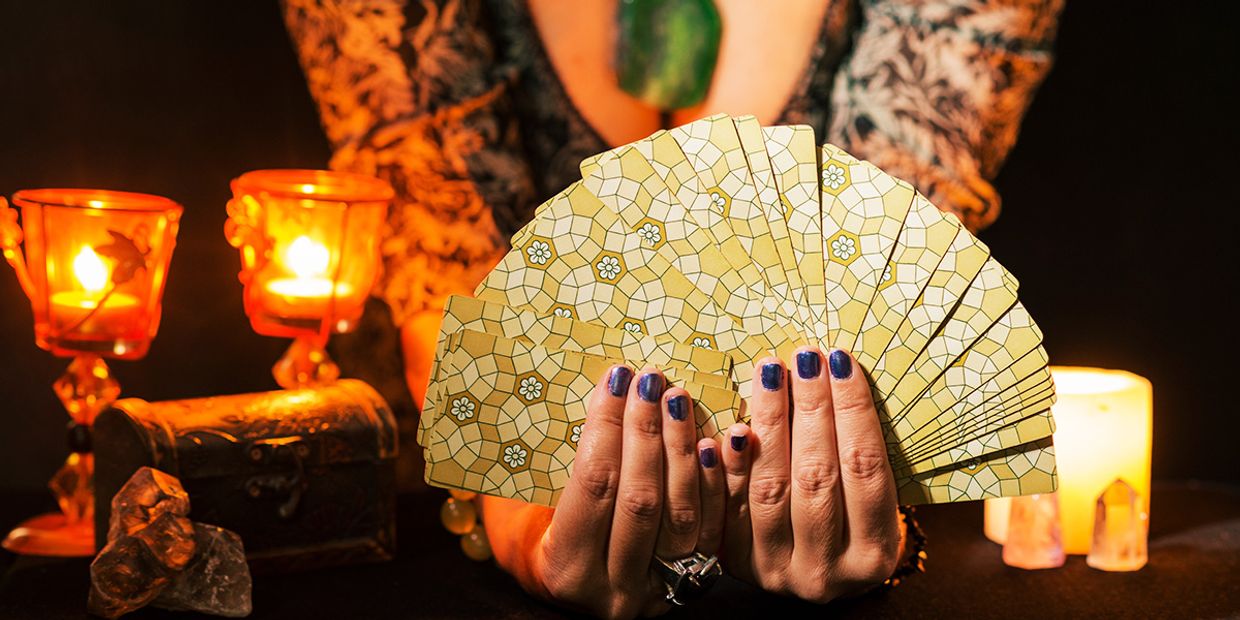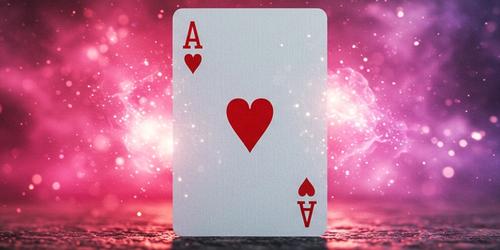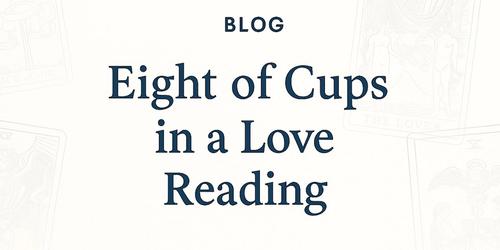
To pay for your reading on your telephone bill, simply call
Instantly message our featured psychics online via psychic messenger.
Click to start
Register now to start your reading online. PSYCHIC MESSENGER- Cheapest psychic service in the UK
- Our readers are available 24/7
- 100% confidential service
- In-depth, concise, personal readings
- Thousands of 5* reviews
Published 12/06/2023 • Updated 17/11/2025 by Joanne Jones
What Is a Tarot Reading?
By Joanne Jones | Expert Psychic Advisor, Trusted Psychics
A Tarot reading is a spiritual practice that utilises a deck of cards to answer questions you may have concerning your emotions, life path, and personal development.
Tarot card meanings can help in gaining insight into our lives because each card has its own meaning, symbolism, and energy that reflect different aspects of our romantic, career, and spiritual journeys.
Tarot readings can provide clarity when we are feeling confused, healing when we are wounded, and guidance when we are lost. It’s no secret that millions of people worldwide turn to tarot readings every day to find comfort and guidance from their higher selves.
In this guide, I’ll be sharing everything you need to know about tarot card readings, including how they work and their history, how to choose a trusted reader, the tarot card meanings, the different kinds of readings and spreads, how to prepare for your first reading, and the benefits of getting a tarot reading online.
📞Wondering what a tarot reading is? Or do you want to understand the tarot card meanings? Contact one of our skilled readers at Trusted Psychics readings today.

The History of Tarot Through the Centuries
14th Century – the Invention of Playing Cards
Tarot playing cards were first introduced to Europe in the 14th century. Believed to have been imported from the Middle East, the earliest decks were playing cards used for games, not for divination.
Research suggests that merchants introduced them along trade routes from Egypt and the Islamic world, where cards with symbols were played as games. These early tarot cards were not mystical, but they set the stage for the tarot deck to come, one of symbolism, art, and storytelling.
15th Century – Italian Tarocchi Decks
Tarot became more recognisable in Italy during the 15th century. Noblemen began commissioning decks of hand-painted Tarocchi. The cards themselves contained their own beautiful and unique symbols, and each deck was different. The cards depicted virtues, life lessons, and aspects of the human experience.
18th Century – the Rise of the Esoteric Tarot
In the 1700s, tarot ceased being regarded as mere playing cards. A new period had arrived where the interest in readings became very popular.
Visionaries like Antoine Court de Gébelin and Jean-Baptiste Alliette (also known as Etteilla) led the charge in France, each proposing that these cards had a deeper spiritual meaning beyond just being an entertaining family game.
19th & 20th Centuries – The Modern Tarot Movement
Secret societies, like the Hermetic Order of the Golden Dawn, started to link tarot with astrology, numerology, and the Kabbalah.
In 1909, the first Rider–Waite–Smith tarot deck was published, and to this day, it remains the most widely used deck of cards. The clear and symbolic imagery of this deck soon became the world standard, used by millions of tarot card readers for spiritual insights, self-discovery, and emotional healing.
The Structure of the Tarot Deck
All tarot decks have 78 cards in total. Each card is illustrated differently and is associated with various aspects of life.
Cards are split into two major parts – Major Arcana and Minor Arcana, both of which are interrelated and together help to tell a story of a human life from a mundane to a spiritual level.
Major Arcana (22 cards): The Major Lessons
Major Arcana cards represent major life events, spirituality, growth, and strong life themes. These cards tend to be major stepping stones in your life.
Well-known cards and their interpretation.
0 — The Fool: New beginnings, bravery, taking risks.
VI — The Lovers: Deep bonds, values, relationships, important choices
X — The Wheel of Fortune: Optimism, good fortune, destiny and free will
XIII — Death Card: Change of direction, a fresh start and new life.
XV — The Devil Card: Patterns, temptation, self-worth and gaining control.
XXI — The World Card: Completion, satisfaction, achievement.
Minor Arcana (56 cards): Daily Life and Spiritual Guidance
Minor Arcana cards are about the energy of day-to-day life: feelings, intentions, interactions, money, and next steps. They are divided into 4 suits (categories) with 4 elements and themes of life.
The Four Suits (and Their General Meaning)
Cups (Water): Emotions & Relationships (Love) Communication, intuition, Nurturing and Healing.
Swords (Air): Communication and Ideas Thoughts & Communication: Honesty, insights, choices, Conflict Resolution.
Wands (Fire): Action & Purpose Passion, Optimism, Creativity, Reason, Confidence.
Pentacles (Earth): Work & Stability Career, Finances, Home, Family Relationships, and Next Steps.
📞 Want to connect with the best tarot readers in the UK? Trusted Psychics readings provide spiritual guidance, compassion, and intuitive insights. Call our team today.
What Is a Tarot Spread?
A tarot spread is the actual arrangement of cards that your tarot reader sets for your reading. Each position in a spread has a different meaning and is associated with an aspect of the situation or query you want to know about.
The card meanings can be assigned to the past, present, emotions, challenges, or outcomes in which you are interested.
A spread can be simple or complicated, taking you from a basic yes or no answer to a deep exploration of your feelings and the choices you are making in your life. Choose a spread that is easy to follow and provides insightful spiritual guidance.
These are some of the most popular tarot spreads used today for you to use to gain new perspectives and direction in your life.
Three-Card Spread: Past, Present, and Future
One of the easiest and most popular spreads for beginners is the 3-card spread. These layouts are great for when you don’t have the time or space for a full, in-depth reading. After all, they’re a quick and easy way to get the answers you’re looking for and some general guidance on your situation.
The position of the cards in a three-card spread relates to your past, present, and future. This is a type of quick reading you can use to clear up any issue or question you are faced with.
The reader will begin by shuffling the deck, then read each card in the context of your question. Then look at all the cards together and read them as a single story.

The Celtic Cross Spread: Gaining Deep Insight and Discovery
A 10-card tarot spread, the Celtic cross is a classic. It is perfect for gaining insight and clarity about the important questions in your life.
Used for life’s big decisions, complex emotional situations, or simply to gain a new perspective on a situation, the Celtic Cross is a staple in the tarot enthusiast’s book.
The Celtic Cross provides a bird’s-eye view of your life by displaying both external and internal forces. This layout is often very informative and accurate, combining both traditional meanings and the individual nuance of each card to provide a powerful, multifaceted reading.
The Relationship Spread: Tarot Readings for Love and Connection ♡
Relationships matter, and getting to the heart of what’s happening between you and another person is important.
The Relationship Spread is a tarot spread you can use to gain a clear picture of emotional energy in a connection between two or more people. It could be your partner, a friend, or even a family member.
The relationship spread can also be used to understand each person’s role in an interaction. This could help to explain misunderstandings and illuminate strengths in the connection.
📞 Call Now: Speak to a trusted tarot reader at Trusted Psychics and uncover what your cards say about love, destiny, and success.
A common seven-card layout for a relationship reading might include:
- You: Your energy in the relationship.
- Them: Your partner or the other person’s energy.
- The connection: The current state of the relationship.
- Challenges: Problems or miscommunications.
- Strengths: What’s keeping you together?
- Advice: Actions to improve the relationship.
- Outcome: The potential result or outcome.
This type of reading for relationships isn’t about controlling your love life. Instead, it helps you get clear on the heart of your connection. From there, you can choose how to nurture it.
📞 Wondering how your love life is going to turn out> Find out with a Love Reading from a Trusted Psychics expert, available 24/7 for real guidance from a real, caring person.
The Purpose of Tarot Readings
Tarot is often requested when people are going through difficult decisions, emotional upheaval, or just a general feeling of being “lost” as to the future. Any situation that causes us worry, doubt, and confusion in our lives can be alleviated with a tarot card reading.
Whether you are seeking insight into a relationship issue, a career question, self-development, or spiritual awareness, a reading with a skilled tarot reader with genuine psychic abilities can provide you with a different perspective and help you to see the “big picture” so that you can make empowered choices and move forward with clarity.

Here are some of the key purposes of tarot readings:
- 1. Gain Insights and Direction
Tarot can be beneficial for times of confusion and indecision. When faced with difficult situations and not knowing the best way forward, a reading can offer guidance and practical steps to take to ensure the best outcome.
- 2. Tarot Love Readings
Love readings are the most popular type of readings that the Trusted Psychics experts are asked for on a daily basis. Love tarot readings can offer clarity and direction when you need gentle yet powerful advice about your relationships, compatibility, soulmate, or another love-related concern.
Fact: According to the results of our 2024 customer survey, which included all callers, 91% of customers requested a love or relationship reading or questions related to love, infidelity, compatibility, and future outlook.
Whether you are curious about a new connection, feeling doubtful in a current relationship, or seeking your ultimate soulmate or twin flame, our experienced readers will have incredible insights to share.
- 3. Career Readings
Career Readings can provide the clarity and confidence you need to move forward with purpose and direction. Whether you’ve recently changed careers, launched your own business, or just want to find more harmony between success and happiness.
Career Readings provide a fresh perspective on the energy around your goals and ambitions. They can help you identify opportunities, remove blocks, and make practical decisions based on insight and foresight.
A good career reading doesn’t just predict success; it helps you understand how to create it, giving you clarity and guidance for your professional journey.
- 4. Spiritual Growth
Spiritual readings centre around your inner world, your intuition, life lessons, and your soul's purpose. These readings are about connecting to higher wisdom and understanding how your current situation or relationship is there to support your spiritual growth.
If you feel disconnected, lost, or ready to take the next step in self-discovery, a spiritual reading might be right for you.
- 5. General Guidance
When you’re unsure what to ask, a general reading gives an overview of your life’s current energy. It highlights what’s most important for you to focus on right now, helping you realign with balance and direction.
📞 Whether you’re seeking guidance for love, money or need some clarity in your life. We have readers available 24/7, so book your session at Trusted Psychics today and see what the cards have to tell you.
How to Prepare for a Tarot Reading
I always recommend preparing for your reading. You may choose to prepare by doing some basic meditation or just creating a space that feels personal and relaxing.
Whichever type of reading you prefer, face to face, online, or psychic messenger, when you take just a short time to prepare before your session, it can be beneficial for a meaningful experience.

Below are some simple tips on how to get the most out of your reading:
- Online or In-Person Tarot Readings
Online tarot readings and face-to-face readings can both be equally effective. It all depends on your personal preference and the connection between you and your reader.
Online readings are one of the most convenient ways to receive a reading from a gifted reader, as you get privacy and can connect with the best tarot readers from all over the world.
You do not need to travel to see a reader, and you will have a wide choice of readers to choose from who are available 24 hours a day.
- Online Tarot Readings
Tarot readings are a personal experience, so it can be beneficial to create a relaxed environment without any distractions so that you can focus and take time to reflect on the answers that you are receiving to your questions.
As the digital age has progressed, online readings are much more common than face-to-face readings, as many customers feel they can open up more to a reader when they are in the comfort of their own home.
Online readings tend to be better value, especially with services like Trusted Psychics, which provide a Fair Pricing Policy with transparent set costs.
Stay open to receiving messages even if they do not resonate with you immediately. Messages may come up that highlight underlying emotions or truths that you may not even be aware of until you’ve had the time to reflect after your reading.
- In-Person Tarot Readings
If you are meeting with a reader for a face-to-face reading. Prepare your questions beforehand, as many people say they do get nervous sitting opposite a reader and can forget their main focus, which they would like their reading to cover.
Trust the experience, let the reading flow and know that many messages often make more sense with time.
At Trusted Psychics, we vet all our readers for accuracy, compassion, and professionalism. Many of them have decades of experience providing readings that bring genuine clarity and comfort to clients worldwide.
The Benefits of Tarot Readings
Tarot readings are an investment in you and your emotional wellness. Each day, millions of people of all walks of life, from all over the world, turn to tarot to help make sense of situations, move forward with greater clarity, and find the peace of mind they need when life gets fuzzy.
Tarot can light the way down new and unexplored paths, whether you’re in the throes of love, a career crossroad, or other life changes.
Over the years, we’ve received emails from our Trusted Psychics clients telling us how our services have provided them with the space and perspective they needed to heal old wounds, make difficult decisions, and regain their strength.
Here Are Some of the Benefits
✔️ Gaining Clarity and Perspective
Life gets overwhelming. We’ve all been there. Everyone has times in their life when it feels like the to-do list just won’t stop growing, and every decision they make is harder than the one before. A reading can be the reset your mind needs and allows you to move forward on the best path.
✔️ Emotional Healing & Inner Peace
Tarot has a long-standing reputation as being therapeutic and healing. For many, it’s like a spiritual form of counselling that gently unpacks buried emotions and releases old wounds, bringing you peace of mind.
The UK Holistic Wellness Association (2024) found that 72% of tarot clients felt calmer and emotionally lighter after their session. Self-reflection and deeper emotional understanding allow you to heal your emotional patterns.
✔️ Strengthening Intuition
Tarot is a two-way conversation with yourself, between your subconscious mind and your conscious thoughts. By sitting with the cards, reflecting on their meaning and how they make you feel, you start trusting yourself more and follow your own intuition.
Regular readings can help you develop a stronger intuition and begin to trust your inner guidance system. You may also find that you rely less on the need for external reassurance and more on your own self-trust.
Joanne Jones Trusted Psychics
Global search interest in tarot has increased by 300% since 2020 (Google Trends).
✔️ Empowering Personal Growth
Tarot is a journey of self-discovery. Each reading you receive helps you learn more about yourself and become a better version of who you are.
Regular readings can help you:
- Recognise and break patterns and habits.
- Release old limiting beliefs.
- Cultivate self-compassion and compassion for others.
- Appreciate and celebrate your strengths and successes.
Tarot is not about predicting the future. It’s about transforming it by transforming yourself. Many Trusted Psychics clients find that regular readings are now part of their self-improvement ritual, alongside meditation or journaling.
📞 Book a consultation at Trusted Psychics today and discover clarity, healing, and empowerment for your journey. Join millions worldwide in finding peace through the cards.
Tips for Choosing the Right Tarot Reader
Finding the best tarot reader is crucial to your experience. When you choose someone to access your future, we believe you should feel connected, heard, understood, and supported.
It’s also worth noting that the best tarot readers in our network vary from person to person. It’s all down to personal energy, vibes, and intuition.
So how do you know who the best tarot readers are, perfect for you?
At Trusted Psychics, we take the time to research each and every one of our tarot readers to ensure they’re fully vetted and verified.
We also provide an unbiased and accurate ratings system, where clients share their genuine experiences to help you decide which reader is right for you. In this guide, we share tips for choosing the best tarot reader for you.
- ✔️ Experience Matters
An experienced tarot reader brings intuition, empathy, and years of professional insight into each and every reading. The more they’ve worked with clients, the more attuned they become to the nuances of the cards. They’re able to translate messages clearly, practically, and compassionately.
Look for a tarot reader with years of professional experience or glowing client reviews.
Seasoned readers are skilled in their ability to provide relatable and practical insight for life-changing results.
Many of our top-rated tarot readers on Trusted Psychics have 20+ years of professional experience.
"A good tarot reader will never just give you the cards. They will help you understand the messages, and they’ll leave you feeling uplifted, not down.” Joanne Jones, Trusted Psychics
- ✔️ Read Verified Reviews
Reviews from past or current customers can be your secret weapon for finding the best tarot reader. Genuine client reviews can tell you everything you need to know about:
- The accuracy and relatability of their insights.
- Their speciality area, such as love, relationships, career, or spiritual guidance.
- The comfort and support they offer in a reading.
Fact: According to our 2024 Trusted Psychics survey, 87% of clients rely on customer reviews to help choose their perfect reader.
At Trusted Psychics, we ensure that every customer review is verified and genuine. That way, you can pick the perfect tarot reader with confidence.
- ✔️ Trust Your Intuition
Listen to your intuition and choose the tarot reader who makes you feel calm and understood. Pay attention to how you feel when you read their bio, listen to their voice, or speak with them online.
If it’s “easy” for you to connect, you may have found your match. If you feel anxious or pressured, keep looking. You and your reader should have “good energy” between you; this helps to set the tone for an accurate, insightful, meaningful session.
- ✔️ Choose a Specialist
Tarot readers have different strengths, specialities, and areas of expertise. Some are particularly talented at love and relationship readings. Others specialise in career, spiritual growth, or emotional healing.
When browsing through our profiles of online readers, find someone who specialises in the area you’re most concerned with. A specialist in your area of concern can offer in-depth, more precise guidance.
- ✔️ Ask the Right Questions
Prepare for your tarot reading by writing down questions or intentions. Ask open-ended questions that seek insight and empowerment:
“What can I learn from this relationship?”
“How can I attract more abundance into my life?”
“What is the next best step for my personal growth?”
Empowering questions set the stage for an on-point, meaningful reading.
- ✔️ Find a Trusted Platform
It’s just as important to choose a trustworthy, reputable site as it is to choose the right reader. Trusted Psychics is one of the UK’s most reputable, established psychic networks, offering:
- Handpicked, verified tarot readers.
- Available 24/7 for chat or phone readings.
- 100% private and confidential sessions.
- Transparent pricing with no hidden fees.
- Real verified customer reviews to help you choose the perfect reader.
When you book through Trusted Psychics, you know you’re getting the highest standards of professionalism, safety, and quality insight, time after time.
Trusted Psychics is a leader in helping people around the world find clarity, confidence, and peace through genuine tarot readings.
📞 Interested in finding the perfect tarot reader for you? Check out our team of expert, handpicked psychics at Trusted Psychics, available 24/7 to help you find clarity, truth, and peace in your life.

Real Customer Testimonials
⭐⭐⭐⭐⭐ “Totally accurate reading! My tarot reader described my love life perfectly. I felt so relaxed afterwards.” — Samantha L, Manchester.
⭐⭐⭐⭐⭐ “Joanne Jones was fantastic. She made me realise why I was repeating the same mistakes in love.” — Emma K, Glasgow.
⭐⭐⭐⭐ “Super insightful reading that helped me to make up my mind about moving jobs. Highly recommend!” — Lucy M, Birmingham.
⭐⭐⭐⭐⭐ “I’ve had readings with other psychics before, but Trusted Psychics was by far the most accurate. Worth every penny.” — Craig T, London.
FAQs: Tarot Reading Explained
What Exactly Is a Tarot Reading?
A tarot reading is a spiritual consultation in which a reader will guide you through a set of cards and offer insight and clarity about the energy, feelings, and forces at play in your current circumstances, dilemma, or decision.
It’s not about foretelling the future or seeing your destiny laid out in black and white, but rather gaining a better understanding of the energies currently affecting your life.
Can Tarot Predict the Future?
Tarot doesn’t show a set, certain, or unchangeable future. Instead, it shows you potential, possibilities, and lessons based on your current energy, choices, and mindset.
Tarot is more like a snapshot of your current life situation and how it might naturally play out if you keep going down the same path you’re on now.
The future is never set in stone, and you always have free will and the ability to change the outcome through your thoughts, actions, and decisions. Tarot can help you make more informed, empowered, and conscious decisions about the future.
How Accurate Are Tarot Readings?
Accuracy with tarot comes down to three factors: the reader’s skill and intuition, the querent’s (the person receiving the reading) focus and openness during the reading, and the question asked.
At Trusted Psychics, we handpick our tarot readers based on their accuracy, empathy, and experience. Clients often describe our tarot readings as “astonishingly precise” or “emotionally spot-on”.
Fact: 9 out of 10 Trusted Psychics clients felt that their tarot reading provided them with clear and relevant insight.
How Much Does a Tarot Reading Cost?
At Trusted Psychics, you can enjoy our affordable tarot readings from as little as £12 each. Unlike many other services, we do not charge high, inflated prices with extra costs for certain readers, so your costs do not escalate to unfair amounts.
Trusted Psychics operates a Fair Pricing Policy so you can ensure you will always get the best value readings by the top UK readers.
We believe in making real, trustworthy spiritual guidance accessible to everyone, at a fair price.
Why Choose Trusted Psychics for Tarot Readings?
Trusted Psychics vets all their readers for authenticity, honesty, accuracy, and compassion. Every reader has an online profile with verified reviews from satisfied customers.
A tarot reading is an opportunity to get back in touch with yourself, to clear your mind, regain your confidence, and find your direction when life feels a little out of focus.
Whether you are looking for answers in love, work, or spiritual growth, the caring and intuitive readers at Trusted Psychics are here to help with honesty, compassion, and insight.
The Trusted Psychics Promise
At Trusted Psychics, we are committed to providing you with the most honest, caring, and empowering experience possible.
Here’s what you can expect when you connect with one of our readers:
✅ Honest, compassionate guidance and intuitive insights — always.
✅ Experienced, verified readers who genuinely care.
✅ Real reviews, verified readers, and honest spiritual guidance.
✅ Empowerment, not prediction, because you have the power to shape your future.
✅ 24/7 availability, so help is always just a call or chat away.
When you call Trusted Psychics, you are more than just getting a tarot reading; you are talking to someone who genuinely cares about your well-being and happiness.
📞 Speak to a trusted tarot reader today at Trusted Psychics and let your cards bring you closer to the love, destiny, and purpose you seek.
About the Author: Joanne Jones is a professional tarot expert with over 20 years of experience in intuitive and spiritual readings. As a lead advisor at Trusted Psychics, Joanne specialises in love, life-purpose, and career readings that empower people worldwide.
Related Articles
5 Interesting Things About Tarot Cards
What to Expect From a Professional Tarot Reading
How To Contact A Trusted Psychic
Phone a live Psychic 24 hours a day
View all our live phone psychic and tarot readers online.
View All Live readersMessage a live Psychic 24 hours a day:
View all our live messenger psychic and tarot readers online.
launch messengerRecent Articles From the Trusted Psychics Blog

The Wheel of Fortune Tarot Card
Discover the Wheel of Fortune tarot meaning in love, career, money and spirituality. Learn upright vs reversed interpretations, symbolism, and destiny messages.

7 of Hearts Meaning in Cartomancy
What does the 7 of Hearts mean in cartomancy? Explore love, career & spiritual guidance. Joanne Jones of Trusted Psychics explains this emotional card in-depth.

What Is the Meaning of 888 Angel Card Readings?
Discover the meaning of 888 in angel card readings. Learn how this powerful angel number guides in love, money, career & spiritual growth with Trusted Psychics.

Ace of Hearts Meaning in Cartomancy
The Ace Hearts card meaning in Cartomancy is one of the most positive & inspiring cards to draw from the deck. Read our guide on what this positive card means.

Eight of Cups in a Love Reading
Read our Trusted Psychics guide on the Eight of Cups in a Love Reading & Its Meaning. We explore if it is a negative card or one that shows you need to let go.

Tarot Readings Online Video
Tarot Readings Online with Trusted Psychics offers concise answers to life's pressing questions. Discover how a tarot reading can give you clarity & insight.

